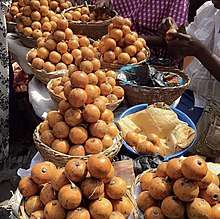Chrysophyllum albidum
Chrysophyllum albidum (commonly known as white star apple[1]) is a forest fruit tree described by the Scottish botanist George Don. It is commonly found throughout tropical Africa.[1]

African star apple
| Chrysophyllum albidum | |
|---|---|
| Scientific classification | |
| Kingdom: | Plantae |
| Clade: | Tracheophytes |
| Clade: | Angiosperms |
| Clade: | Eudicots |
| Clade: | Asterids |
| Order: | Ericales |
| Family: | Sapotaceae |
| Genus: | Chrysophyllum |
| Species: | C. albidum |
| Binomial name | |
| Chrysophyllum albidum | |
Amongst the Yoruba of Nigeria, it is called Agbalumo while it is called Udara in the eastern and southern parts of Nigeria, and in the northern (Hausa-Fulani) Part of Nigeria popularly known as Agwaluma .[2] It is closely related to the African star apple (Chrysophyllum africanum) which is also common throughout West Africa. Some schools of thought feel that they may just be a variety of the same species. Also in the family is the purple star apple (Chrysophyllum cainito).[2]
References
- "Chrysophyllum albidum". Germplasm Resources Information Network (GRIN). Agricultural Research Service (ARS), United States Department of Agriculture (USDA). Retrieved 12 March 2013.
- Lost Crops of Africa: Volume III: Fruits. Washington, DC: The National Academies Press. 2008. p. 321. ISBN 978-0-309-10596-5.
External links
- Interagency Taxonomic Information System
- Health Benefits Of White Star Apple
- Kew Royal Botanic Gardens
- Dressler, S.; Schmidt, M. & Zizka, G. (2014). "Chrysophyllum albidum". African plants – a Photo Guide. Frankfurt/Main: Forschungsinstitut Senckenberg.
This article is issued from Wikipedia. The text is licensed under Creative Commons - Attribution - Sharealike. Additional terms may apply for the media files.